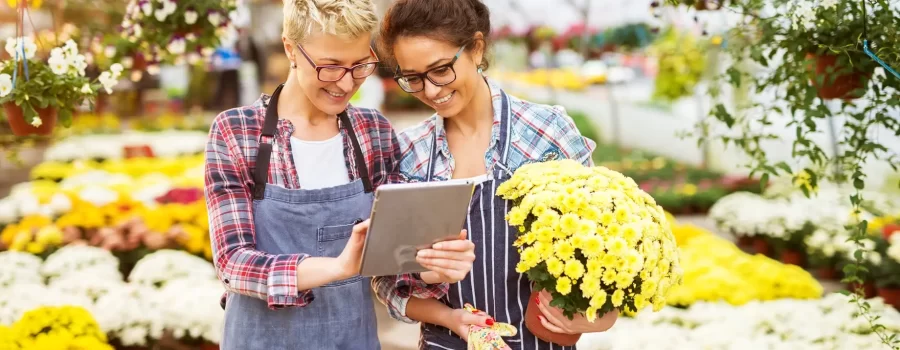One of the pain points for customers at any retail establishment is waiting in line. It’s also their final impression of your store, so considerations for improving the checkout process are important, and should be factored in as part of the overall experience.
For the past several years, mobile point-of-sale systems have been used primarily for line busting and moving customers through checkout more efficiently. Customers get tickets for some items, say heavy trees or shrubs out in the nursery yard, and bring the receipt to the register instead of lugging the large plants through the garden center to the checkout area.
Mobile systems are still being used for that purpose, but with new capabilities and technology, there is much more they can offer. Mobile devices can be a large investment, however, so whether these systems are right for you and when is a good time to invest are important considerations when deciding.
Evolution of mobile devices and point-of-sale systems
Independent garden centers generally use mobile devices for a few primary purposes: line busting; to start or complete a transaction in an area other than the checkout center; to sell outside of the store, for example, a farmers market; and to manage inventory, deliveries and other back-office tasks, says Andy Smith, business development manager for Rapid Garden POS.
In the past, separate devices were required to manage individual processes, like credit card payments and product scanning, but new point-of-sale capabilities can merge these functions.
“For Microsoft Windows-based systems, you can now run the exact in-store point-of-sale on a Windows tablet — it can have all the features and functionality as if you are sitting in front of the register, and there’s no learning curve because they are all the same screens,” Smith says. When these tablets first came out, they were cumbersome and bulky, but newer models are lighter and more user-friendly, he says.
The hardware required to operate these systems is also more affordable than the in past, says Sam Kirkland, strategic relationship manager for Epicor Software.
“We had a RF (radio frequency) gun that could scan the product and print an invoice to take to checkout. The focus was to speed up the existing physical checkout lane to move people quicker. The hardware itself really priced the small retailer out, so it really wasn’t a solution,” Kirkland says. “It’s really transitioned from that RF gun, that had limited functionality, to a mobile tablet where I have a fully functioning point-of-sale.”
Benefits of mobile options
With newer systems, instead of giving customers tickets to take to the register, staff can search product information or process transactions wherever customers are in the store, all while updating inventory systems and accounting for rewards programs and coupons. Some systems can handle all of those capabilities on one device, but others require add-ons or separate devices, Smith says.
Whether garden centers use tablets to handle transactions outside of the physical register, tablets linked to the store’s inventory can help staff better assist customers, especially if that system is tied with the store’s overall inventory management interface.
“The nice thing about the surface tablet is in a garden center environment, I can zoom in on a product the same way I can on a register, and help [customers] look up items. It makes it easier to work, it’s familiar for [staff] and helps them help the customer better,” Smith says.
Some point-of-sale systems also come with docking stations, so the devices can be used as stationary registers in the regular checkout area or as mobile point-of-sale devices, Kirkland says.
“An existing point-of-sale station can become multipurpose with a tablet, and if I so choose, I can grab that tablet out of my designated point of sale station and walk around with the customer,” he says.
Determining if mobile point-of-sale is right for you
Smith asks IGC owners and managers a few questions to determine if mobile devices would be a fit at their stores.
“When I talk to a store that’s looking to change their technology, I typically ask, ‘would mobile devices be helpful for you? Do you have certain times when you are selling outside of the store? Are there certain times of the year when adding that extra capacity to ring someone up elsewhere in the store would be helpful? Would it be helpful to have a mobile device to receive inventory, generate purchase orders or make inventory adjustments?’” Smith says. He also asks how often the IGC needs that capability — whether they want to use the technology year-round or only need it during the busiest weeks within key seasons.
“I also ask, ‘are there any specific hardware requirements or conditions that should be considered?’” Smith adds. This helps determine if retailers prefer “a tablet versus something more ruggedized that can get wet and get dropped.”
Kirkland says that determining the exact ROI of mobile systems is difficult, so he also asks a few questions before offering advice to his customers on whether to invest in mobile technology.
“What is the vision of the business? If part of the vision is ensuring customers have a pleasurable experience in the store and a quicker check out, mobile devices can help. Is the business looking at improving the number of customer visits per year, or line items per transaction? If those are their goals, going mobile can help achieve that,” Kirkland says. “We’re in a great era where hardware costs are going down. [As an independent garden center owner,] if I only have one Saturday a year when I need help, I may not go that direction, but next time I buy a PC, I might ask, ‘should I buy a tablet instead of a PC?’ As I start upgrading technology, I need to understand what will advance my business in the industry. PC and laptop sales are declining in retail businesses and tablets are increasing, so the adoption of the technology is growing year over year.”
Another consideration that both Smith and Kirkland emphasize is whether the garden center needs to conduct business somewhere other than its physical store. This could be at farmers markets, charitable events, community flower sales or in customers’ yards if the garden center offers landscaping or consulting services.
Good customer service is also another key component this movable technology can provide, Smith says.
“[Customers] want to have a very hands-on, concierge-type of experience where people are walking with you to help you choose things for your garden or for your landscape,” Smith says. “[It’s beneficial] to be able to walk around with that customer and have that information in real-time,” especially in garden centers that offer consulting and landscaping.
Important considerations
If you do determine that mobile payment devices and point-of-sale systems are right for your garden center, implement them before the busy season, Smith says.
“Always do your training and [test] the capabilities of your mobile devices before your busy season,” Smith says. “You don’t want to realize you have a glitch and that this isn’t working properly in the middle of one of your busiest weekends.”
Before implementing any technology, it’s also important to consider the IGC’s specific customer base and their preferences, he adds.
“Know your customers. If your customer base doesn’t like email receipts and wants printed receipts, you need to make those available in the store on a printer that can connect to those mobile devices. Think through the right configuration for your environment,” Smith says.
Especially if you are using mobile devices to check out customers, they need to carry the same capabilities as your register or stationary point-of-sale, Smith says. Customers should be able to accrue and redeem loyalty points.
Protecting the customer data these mobile systems process should also be top of mind, Kirkland says.
“If we’re conducting credit card activity on mobile devices, it needs to be secure. This should be part of the point-of-sale system, and, since some software vendors don’t offer hardware or network security support, retailers must verify if adequate measures are being taken by their software provider,” he says. “Security needs to be a focus and a high priority for each retailer — large or small.”
Taking time to properly train staff may seem obvious, but it’s a challenge businesses have faced. Employees can become nervous using the technology for the first time in front of customers, so it’s important that they are comfortable with the system before a busy day. And, have a system in place so that employees are accountable for the hardware and are deterred from losing it.
Another important aspect of employee training is making sure the devices are charged at all times and that staff understand both the capabilities and limitations of them, Smith says.
“When you’re assessing what’s right for your store, understand that each mobile device has its own way of updating and synchronizing with the data in your store,” Smith says. “In some mobile devices, there are some capabilities you can perform offline until you are back in your network. Offline functions can be helpful for doing inventory adjustments in the far reaches of your greenhouses. But it will not help an IGC who is looking to ring up transactions in real time.”
Even if your garden center determines mobile point-of-sale options are not feasible now, Kirkland says it’s important to keep them in mind for the future.
“Laptops and desktops are going away, and it’s all going to the cloud,” he says. “This technology is rapidly being used … Customers don’t have to find some little area where there’s a cash register where they may not know where it is. People can choose where they shop. They are going to choose to shop where it’s fun and they feel that they are taken care of.”
Read the original article here.




